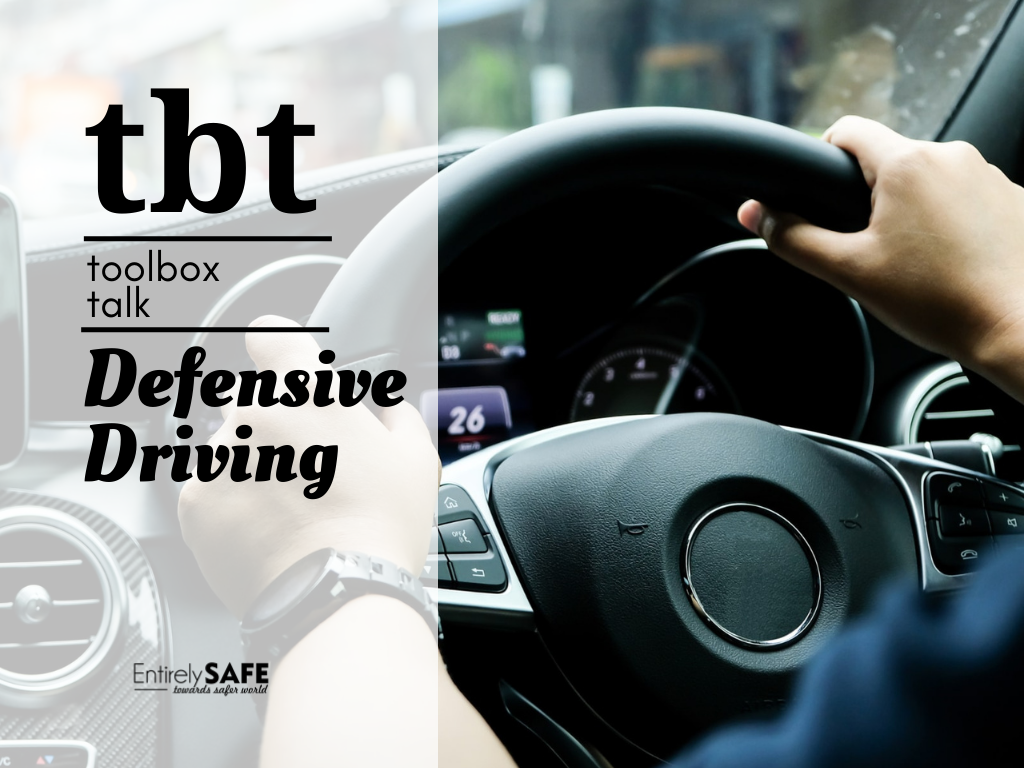Defensive Driving Toolbox Talk

Before the Toolbox Talk
This safety talk is designed for discussion leaders to use in preparing safety meetings. Set a specific time and date for your safety meeting. Publicize your meeting so everyone involved will be sure to attend. Review this safety talk before the meeting and become familiar with its content.
Make notes about the points made in this talk that pertain to your workplace. You should be able to present the material in your own words and lead the discussion without reading it.
Seating space is not absolutely necessary, but arrangements should be made so that those attending can easily see and hear the presentation. Collect whatever materials and props you will need ahead of time. Try to use equipment in your workplace to demonstrate your points.
Give the safety talk in your own words. Use the printed talk merely as a guide. The purpose of a safety meeting is to initiate a discussion of safety problems and provide solutions to those problems. Encourage employees to discuss hazards or potential hazards they encounter on the job. Ask them to suggest ways to improve safety in their area. Don’t let the meeting turn into a gripe session about unrelated topics. As a discussion leader, it’s your job to make sure the topic is safe. Discussing other topics wastes time and can ruin the effectiveness of your safety meeting.

Toolbox Talk: Defensive Driving
When you’re at the controls of any vehicle, it is important to remember that defensive driving is a full-time job. The most dangerous mile you have to drive is the one directly ahead of you. Anyone can drive perfectly for 10 feet or 100 feet or even one mile, but it takes a real professional to drive perfectly for 100,000 miles or more. To be a professional driver there are many things you must observe and practice.
A safe driver is not merely someone who has been lucky enough to avoid accidents but is one who drives defensively and looks out for others. But today’s driving standards demand more skill, knowledge and decision-making ability.
Drivers who are safety-conscious have developed good habits and practice them daily. Every time they get behind the wheel, their driving record is on the line. They must drive like a professional and be prepared mentally and physically.
If you are a driver who has a safe attitude about your driving, you will be able to drive with a sense of security in inclement weather, on difficult roads and through heavy traffic.
In addition, to be a good driver you should respect all traffic laws and be courteous to others. Don’t be in a big hurry – you’re just asking for trouble.
When bad weather affects driving conditions, you must adjust your driving time and habits. Driving on wet or slippery roads is not the same as driving on dry surfaces. The number of traffic accidents and cars running off the road during rainy weather could be reduced if drivers would anticipate the slippery road conditions and adjust their driving habits.
Stay a safe distance from the vehicle in front of you–one vehicle length for each 10 mph. Start stopping sooner. Apply your brakes the instant you see a hazard developing, but apply them gradually so you don’t go into a spin or grind to a stop so quickly that you risk a rear-end collision.
Defensive driving is driving to prevent accidents, in spite of the incorrect actions of others or adverse weather conditions. Anticipate driving hazards and know how to protect yourself from them. Be alert while driving by keeping your mind free of distractions and your attention focused on driving; alertness involves watching and recognizing accident-causing factors instantly. The professional driver has foresight, the ability to size up traffic situations as far ahead as possible. The driver must anticipate traffic problems that are likely to develop and decide whether these developments could be dangerous.
Many drivers fail to understand why they were given a “preventable” for an accident when they were not legally at fault. A “preventable accident” is one in which you fail to do everything you reasonably could have done to prevent it. Even though the driver cited with a “preventable accident” did not violate any traffic laws, the professional driver should have seen or anticipated the incorrect actions of the other driver in time to take actions to prevent the accident from happening. However, you may also learn the valuable lessons that near-misses offer and make the necessary adjustments in your driving habits.
As a defensive driver you must operate your vehicle in a manner to avoid contributing to an accident or being involved in a preventable accident.
Awareness of the vehicle’s limitations is essential; pre-trip checklists and inspections can familiarize you with the vehicle and point out things that might need attention.
Interactive Discussion
- Have you or someone you know been injured or nearly injured while carrying out this activity? What happened?
- How can we stay safe today?
- What do we do at the worksite to prevent injuries related to this activity?
After the Toolbox Talk
At the end of the meeting, ask employees to sign a sheet on the back of this talk as a record that they attended the safety meeting. Keep this talk on file for your records.

